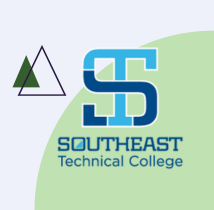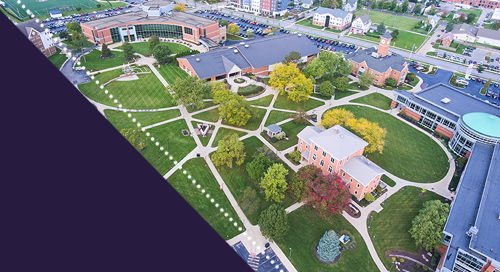
The Southern Association of Colleges and Schools Commission on Colleges (SACSCOC) is a commission dedicated to higher education. It covers the the accreditation of degree-granting higher ed institutions in the Southern US states — primarily in Alabama, Florida, Georgia, Kentucky, Louisiana, Mississippi, North Carolina, South Carolina, Tennessee, Texas, Virginia — as well as Latin America and other international sites approved by the SACSCOC Board of Trustees that award associate, baccalaureate, master’s, or doctoral degrees. SACSCOC also “accepts applications for membership from domestic institutions in the other 39 states, as well as international institutions of higher education around the world.”
Accreditation indicates that an institution meets and exceeds quality standards and is committed to continuous improvement. Having a respected association like SACSCOC extend accreditation to your college or university speaks to the standards upheld by your institution and your dedication to providing the best educational experience for your students.
What is SACSCOC accreditation?
The Southern Association of Colleges and Schools Commission on Colleges (SACSCOC) is an institutional accreditor for quality assurance in higher education. This commission is the accreditation body of degree-granting institutions within the jurisdiction.
Having SACSCOC accreditation signifies the following about a higher education institution:
- They have a mission suitable for higher education.
- They provide the resources, programs, and services to support and maintain that mission.
- They sustain outlined educational objectives that complement the mission and indicate its success in achieving its stated goals.
Colleges and universities must be eligible and meet the criteria set forth by SACSCOC’s standards to receive accreditation. They must meet the prerequisites, provide the necessary documentation, and apply.
What schools are eligible for SACSCOC accreditation?
To be eligible for SACSCOC accreditation, a higher-education institution must be degree-granting and located in one of the following states in the US:
- Alabama
- Florida
- Georgia
- Kentucky
- Louisiana
- Mississippi
- North Carolina
- South Carolina
- Tennessee
- Texas
- Virginia
The association also evaluates US schools located in Latin America, as well as certain other approved sites both domestic and international.
In addition, the institution needs to comply with the standards noted in the Principles of Accreditation: Foundations for Quality Enhancement. This resource was updated in April 2024 and provides detailed information about SACSCOC and its requirements. The SACSCOC Board of Trustees assesses each school and makes accreditation decisions using this document.
SACSCOC accreditation process overview
Obtaining accreditation from SACSCOC requires following a procedure that includes four phases. The following outlines the process:
1. Pre-application workshops
Before becoming eligible to apply for membership, prospective applicants must partake in two different virtual events — the Pre-Applicant Workshop and the Pre-Applicant Institutional Effectiveness Workshop.
Each workshop has two parts. The first is for watching slide presentations, and the second is a virtual meeting where prospective applicants can discuss and address questions. Institutions can register only two people to participate in these workshops. There is a fee per participant for each workshop.
2. Preparation and submission of membership application
The next phase involves preparing the Application for Membership document. Preparing the application requires anywhere from several months to one (or more) years. SACSCOC shares additional information and documents to help applicants gather their information and prepare their forms.
3. Candidacy committee visit
Next, a Candidacy Committee visit occurs if the applicant successfully fills out the membership application and meets all standards. The Candidacy Committee travels to an institution’s main campus and off-campus sites at the institution’s cost. At its next meeting in either June or December, the SACSCOC Board of Trustees will review the Report of the Candidacy Committee. Using this report, the Board will deny or grant Candidacy status.
Candidacy doesn’t equate to accreditation. If an institution is granted candidacy, it simply means they’ve met the basic requirements and are eligible for further review.
4. Accreditation committee visit
If the Board of Trustees bestows Candidacy onto a school, the next step is a visit from the Accreditation Committee. Like the Candidacy Committee, the Accreditation Committee will visit the main campus and any additional off-campus instructional sites at the institution’s expense. They’ll create their own report based on their findings, which the SACSCOC Board will also review in either June or December at their meeting. With their report, the Accreditation Committee recommends whether the institution should be granted accreditation.
When preparing for the visit, SACSCOC accreditation standards require applicants to complete a Compliance Certification report. The report must include documentation and supportive evidence demonstrating your institution’s compliance with SACSCOC standards. The Board considers all this and is the ultimate decision-maker. The Board can agree or disagree with the Committees’ recommendations and either grant or deny accreditation. If the Board of Trustees grants accreditation, it is good for five years before needing reaffirmation.
SACSCOC reaffirmation process
In addition to the Candidacy Committee’s reviews of potential candidates and the Accreditation Committee’s reviews of institutions seeking membership, the SACSCOC Board of Trustees performs reviews for a few additional reasons after granting accreditation. They include:
- Reaffirmation Committee reviews: After five years of membership, SACSCOC requires member institutions pursuing continued accreditation to complete a comprehensive review to reaffirm.
- Special Committee reviews: The Board completes a Special Committee review of member institutions looking for continued accreditation after evaluating accreditation-related institutional circumstances.
- Substantive Change Committee reviews: This review involves a member institution seeking approval and continued accreditation following a significant modification or expansion to the institution.
The reaffirmation process involves two main phases. The first phase is preparation by the institution. Members must complete and submit the Compliance Certification 15 months before the scheduled affirmation. Six weeks in advance of the On-Site Reaffirmation Review Committee, members must submit their quality enhancement plan (QEP). The QEP describes how an institution plans to enhance student success and learning and address related issues. Rather than analyze past and current procedures, this report outlines how the institution will continue to improve over the next accreditation period.
For the second phase, the Commission on Colleges has committees conduct off-site and on-site reaffirmation reviews, followed by a review from the SACSCOC Board of Trustees. The Association shares final decisions at the annual business session in December.
SACSCOC accreditation faqs
SACSCOC accreditation can be challenging to understand, especially when undergoing the process for the first time. Here are the answers to a few more questions you may have.
What happens if candidates or accredited institutions fail to comply with SACSCOC standards?
Failure to meet SACSCOC standards can result in denial of accreditation or reaffirmation. In less severe cases, SACSCOC may request monitoring reports to demonstrate the institution’s attempt to comply with the standards. Institutions can also be issued warnings or placed on probation until they meet SACSCOC standards.
How can you determine if an institution is SACSCOC accredited?
SACSCOC-accredited institutions should provide an accreditation statement in their handbook or catalog. SACSCOC requires institutions to disclose their accreditation status publicly, whether that status is in process, granted, or on probation. You can also search for accredited institutions on the SACSCOC website.
What is SACSCOC looking for?
Overall, SACSCOC considers institutional integrity, commitment to quality enhancement, and student learning outcomes. Specifically, they want to see:
- A fitting mission.
- Appropriate resources, programs, and services to reach institutional goals.
- Clearly specified educational objectives.
- Proven ability to assess achievements and demonstrate improvements.
Does SACSCOC accredit online institutions?
When an institution becomes SACSCOC accredited, the entire institution holds that accreditation. This includes online programs, off-campus learning sites, branch campuses, and any other distance learning programs. Many institutions offer a variety of traditional, in-person, and online courses or programs that would fall under the institution’s broader SACSCOC accreditation. You can check with the institution itself or search for the institution on the SACSCOC website’s Institution Search, entering the institution name and clicking on the institution you are interested in to look at “Available programs.”
What are the benefits of SACSCOC accreditation?
Accreditation offers many benefits, including access to federal aid, transfer credit, and high-quality education for students. When students apply for jobs, having a degree from an accredited institution highlights the value of their education, which can lead to more opportunities and increased earnings.
Your institution also benefits from enhanced reputational value, increased enrollment, and effective recruitment of top faculty. The accreditation process also encourages you to continuously improve, which ultimately boosts student success. Faculty gain credibility as part of an accredited institution and enjoy other benefits like an improved teaching environment, collaboration, and professional development opportunities.
How can faculty and staff contribute to the accreditation process?
The information from faculty members is a central part of accreditation. Faculty can use their expertise and observations of daily operations to streamline the process. Accreditation begins with the self-study. Faculty and staff who participate in self-review provide crucial data about your institution’s overall performance and highlight improvement opportunities.

Faculty and staff are most familiar with your institution’s core functions. Alongside identifying improvement opportunities, they can proactively work to find solutions for these areas. You can collaborate with them throughout the process to get recommendations on teaching advancements, research, academic freedom, and governance.
How can students participate in the accreditation process?
Students can participate in the accreditation process in several ways. Surveying students offers insights into their educational experiences so you can assess your strengths and improvement areas. They can participate in focus groups to discuss support services, curricula, and overall satisfaction. You can also involve students in assessing their own learning outcomes and providing feedback on course effectiveness and alignment with institutional goals.
How Watermark can help you prepare for SACSCOC accreditation
Data is at the heart of your accreditation process. Having the right data at your fingertips means you can demonstrate your impact, and provide evidence of your narrative. Watermark offers a suite of solutions that gather, analyze, and transform your data into actionable insights that allow you to showcase your progress with ease. Our robust accreditation readiness solutions help you build strong processes so that you’re always ready for accreditation without the last-minute scramble.
We designed Watermark Planning & Self-Study to make life easier for higher education institutions. It centralizes all your strategic plans, goals, and assessments to create a streamlined, repeatable process that keeps everyone on the same page. Just some of the benefits of our award-winning solutions include:
- Bringing stakeholders and data together.
- Capturing input wherever it happens.
- Providing templates for most accreditors.
- Simplifying self-study accreditation.
- Offering a sleek, user-friendly interface.
- Supporting data transparency.
- Building automated, intelligent curriculum maps.
- Facilitating comprehensive program review reporting.
- Integrating labor market data for strategic planning.
- Creating multistage workflows to capture reviewer feedback.
- Measuring academic and non-academic outcomes in one place.
- Achieving consistent data readiness.
- Engaging your entire institution in continuous improvement.
- Driving curricular innovation.
- Improving student outcomes.
- Demonstrating faculty engagement.
Streamline accreditation preparation with Watermark

Accreditation is a complex and time-consuming process, but with the right suite of tools, you can drive improvement and gather meaningful data in a fraction of the time. With over 20 years of experience helping thousands of colleges and universities, we can empower your institution to look beyond the numbers and create and support meaningful practices.
Our higher education software supports continuous improvement, with several solutions spanning every aspect of your institution. The complete Watermark Educational Impact Suite (EIS) offers a centralized system capable of driving critical action and continuous improvement. You can work more strategically and effectively, making data-driven decisions that support successful accreditation. Want to learn more about what Watermark can do for your institution? Request a demo today!
































































































































































































































































































































































































